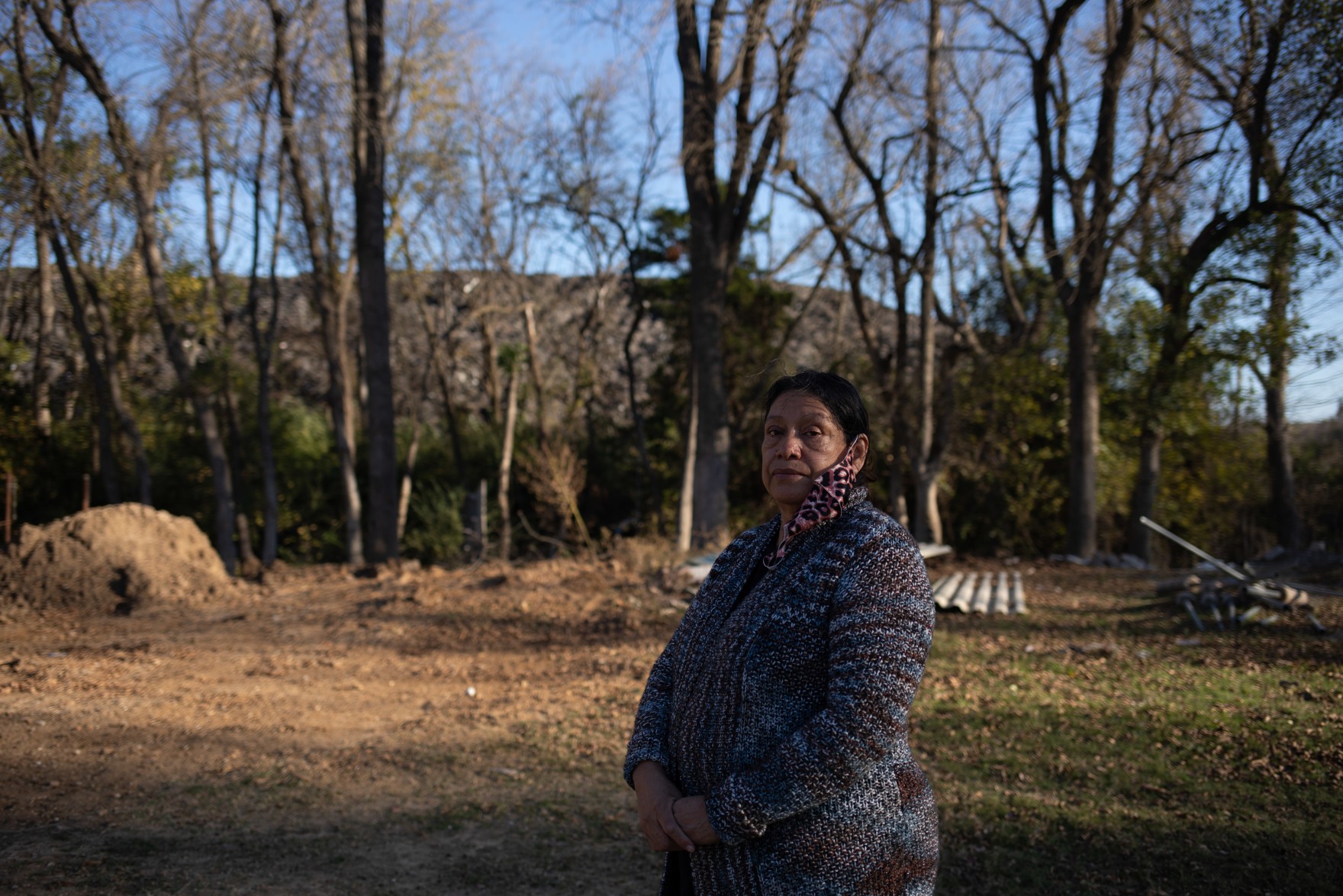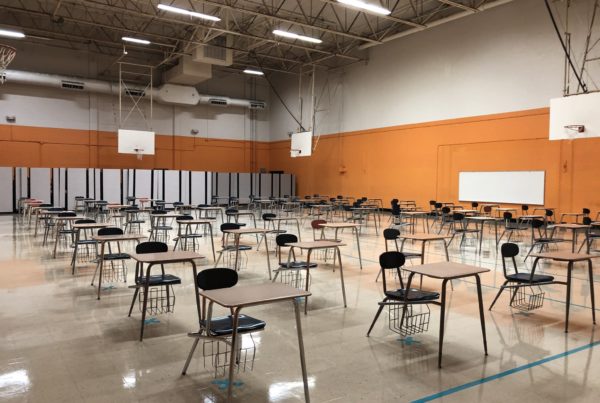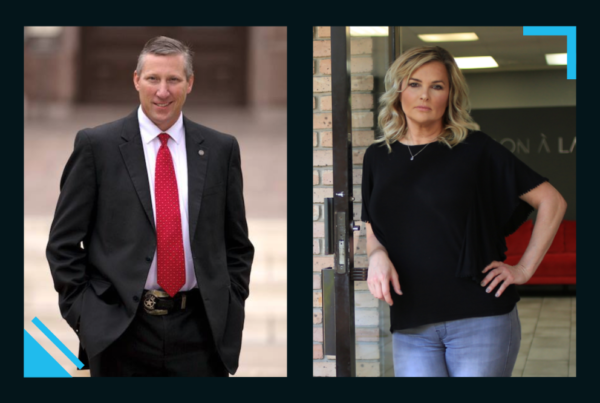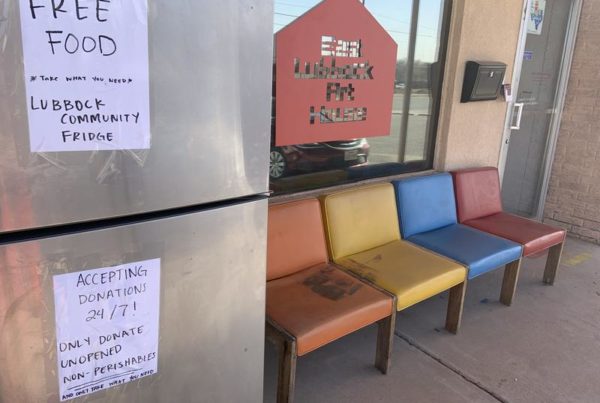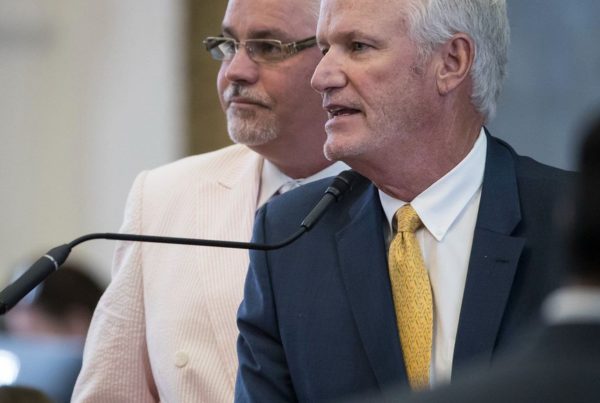From KERA:
This is the latest in a series of stories about Shingle Mountain. Read more from the series and other stories about how Shingle Mountain is affecting Dallas residents and the city’s plan to remove it.
When the wind blows across the houses of Choate Street, it’s not only leaves that are carried by the breeze, but also brown dust and fiberglass that travels from the monstrous 100-foot-tall pile of roofing debris known as Shingle Mountain.
The mound of waste has been Cecilia Del Toro Garcia’s neighbor for nearly three years.
Garcia moved with her husband to Floral Farms in southeast Dallas more than a decade ago. This is a predominantly Black and Latino agricultural community. The family sought a new home at the time and were drawn to the country feel and quietness of this neighborhood.
When they first moved Garcia would spend much of her time gardening in the backyard. She grew tomatoes, pumpkins, cucumbers, chiles and carrots. Now, nothing grows, Garcia says.
Originally from Coahuila, Mexico, Garcia describes the importance of family and how she dreamed of seeing her three granddaughters grow up, run and play with the family’s bulls, horses, goats in this community.
Yo siempre he pensado que tengo una obligación de dejarle algo a mis niñas ya sea esta casa pagada con todas sus facilidades, Garcia said in Spanish. “I feel a sense of obligation to leave something behind to my granddaughter. Like this house fully paid for.”
Little did Garcia know they would get a gruesome neighbor in 2018.
Garcia’s property is like a tiny farm. There are stables with horses and one bull, her favorite animal. You can hear goats bleat in the background.

Shingle Mountain is seen from Floral Farms, on Choate Rd., on Aug. 5.
Directly ahead, a couple dozen feet away, stands the massive trash dump that has hampered her motivation to do simple everyday things. Garcia says she feels tired all the time and has difficulty performing life tasks because of the effects of the waste.
Me la paso arriba de la cama. No más acostada viendo televisión pensando en los problemas que han. Cuando van a quitar esa montaña y si mis hijas van estar saludables, Garcia said. “I spend my days now in bed. Lying down watching TV… thinking about the problems I have like when are they going to remove that mountain? And are my daughters going to be healthy?”
In 2018, the company Blue Star Recycling bought the property and started dumping hundreds of tons of roofing materials next door to Garcia’s house. This continued for almost three years — creating an illegal dump so large it’s visible from the South Central Expressway. Activists call it “a poster child for what environmental racism looks like.”
Shortly after the dumping started, Garcia said she noticed the air turned dry. She points to her white mailbox and says she constantly needs to clean it and her cars to remove all the black dust from the mountain.
Garcia said she also has constant nose bleeds. She doesn’t know for sure if it’s directly tied to Shingle Mountain, but blames it for making her sick. Garcia is one of 5 million people in Texas without medical insurance.
Resident Turned Environmental Activist
Marsha Jackson lives next to Garcia. When near the debris, Jackson wears long sleeves and a mask. She worries about people who get too close to the site.

Marsha Jackson stands in her backyard, where Shingle Mountain towers in the background. Jackson has been fighting for the removal of the toxic waste dump since 2018.
“The headaches are just crazy. All this ground up shingles is blowing…” Jackson said. “That fiberglass is going off into my throat, and the fiberglass just irritates my vocal cords.”
Jackson’s lived in her current home since 1995 and can see the mountain from her window. She has her own set of health complications. According to her, she sees a speech therapist because debris from Shingle Mountain is affecting her voice.
Jackson has been the neighborhood’s top advocate, partly because many of her Black and Latino neighbors fear retaliation from the city or the company that created the illegal dump site.
Glancing at the mountain towering near her home, she recounted how quickly the pile grew once dumping started.
“Within one week, it had grew up over my house,” Jackson said. “I started beginning calling then I went on and went on, nobody still called me.”
She started calling the city of Dallas in February 2018, almost three years ago, asking them to remove Shingle Mountain. When nothing was done, Jackson created the environmental group called Southern Sector Rising.
The group has been calling for the city to tear down what they’ve described as a symbol of environmental racism. They’ve rallied and protested.
Many from the faith community have stood behind Jackson, including Frederick Haynes of Friendship-West Baptist Church.
“We are not a toilet. Whenever you have good home training you clean up your mess. And we are saying to Dallas City Council, you made this mess so clean up your mess,” Haynes said at a demonstration in August.
Others who’ve joined the fight include, Downwinders At Risk, Mothers Against Police Brutality, In Defense of Black Lives Dallas and LatinX Dallas. These groups question the city’s commitment to cleaning up the site.
“It’s really just cruel that it’s taken them this long. We don’t know what clean-up means,” Evelyn Mayo, chair of Downwinders At Risk , said in September. “We don’t know when they are talking about it and we don’t know how long this is going to take. So without that level of detail it’s just words.”
Together the groups have made public statements like carrying brown sacks filled with roofing materials from Shingle Mountain to Dallas City Hall Plaza and posting a giant calendar in front of the huge pile of waste to mark the days until its removal.
The Long Haul To Remove Shingle Mountain
Trying to tear down the mountain has not been easy. There’ve been many legal challenges against Blue Star Recycling over the site.
In December 2018, the City of Dallas sued the company for “a large-scale illegal dumping and industrial waste being dumped into the city’s storm sewer system in violation of the City’s stormwater permitting requirements.”
In 2019, Judge Gena Slaughter ordered the owners, Blue Star Recycling, to remove the pile within 90 days, but the mountain remained. Marsha Jackson is suing Blue Star and the city.
Dallas City Mayor Eric Johnson says the city is not responsible for the mountain, but is doing something about it.
“No one wanted Shingle Mountain to be there,” Johnson said at a press conference outside Dallas City Hall in November. “No one at City Hall is confused about what we needed to do to address the problem.”
The mayor said “it shouldn’t take very long” to remove Shingle Mountain. In September the city announced it was taking bids for the the task. In October, they approved a $450,000 contract with Roberts Trucking, Inc. to remove the pile of shingles and haul it to a city landfill. Legally the process couldn’t start until a public comment period ended Dec. 7. The city’s now waiting for final state approval.
Dallas’ zoning is partly to blame for Shingle Mountain.
“It’s long overdue to really have it be understood that this conversation about South Dallas is really a conversation about neglect, and about underinvestment,” UT-Arlington professor Kathryn Holliday said. “About a series of choices, made across decades, that have led to the pairing of lower property values with industrial development.”
Holliday has long studied how the history of architecture and infrastructure shapes issues of equity in Dallas. She said this story isn’t new. It traces back to segregationist residential laws and redlining.
“There’s a pattern of neighborhood by neighborhood by neighborhood — gravel pits, construction equipment sites, all of these kinds of semi-industrial or light industrial uses concentrated along the railroad tracks and along the highways in South Dallas,” Holliday said. “The city has done very little to control that pattern of illegal dumping historically.”
Historically environmental protections haven’t existed if you live South of the Trinity River in Dallas, she said.
Just like the Floral Farms community where Cecilia Del Toro Garcia and Marsha Jackson live, Joppa, a South Dallas community first established by emancipated slaves in 1872, has also been polluted by industrial development.
Earlier this year, prompted by the COVID-19 pandemic, the historically Black Paul Quinn College analyzed data from the Texas Commission on Environmental Quality (TCEQ) and found that the majority of the city’s industrial facilities are located in southern Dallas.

Map showing redlining in Dallas in 1937. The red areas were defined as “hazardous.” Areas in yellow were described as “definitely declining.” Green neighborhoods were considered the “best,” while blue was thought of as “still desirable.”
“If you sort of look at the way that the pollution burden is distributed by zoning throughout the city, you can see where the concentrations of pollutants are actually allowed to be higher in neighborhoods that look like this neighborhood,” Paul Quinn Vice President of Academic Affairs Chris Dowdy, said, referring to Floral Farms.
Given the city’s history of oppression, Dowdy said there’s nothing shocking about the study’s findings.
“I just think we see the legacy of systemic racism and a really tangible way,” he said.
According to the report, Garcia and Jackson’s zip code is one of Dallas’ worst for bad air pollution. There are high concentrations of dust, soot and smoke in the area, resulting in a shorter life expectancy.
Marsha Jackson wants the city to guarantee environmental protections from air pollutants to the families of Floral Farms.
“This is my life. My doctor had told me that the only way I get better, if that property, that pollutant is moved, or either I move or I eventually died.”
Got a tip? Alejandra Martinez is a Report For America corps member and writes about the economic impact of COVID-19 on marginalized communities for KERA News. Email Alejandra at amartinez@kera.org. You can follow Alejandra on Twitter @_martinez_ale.


